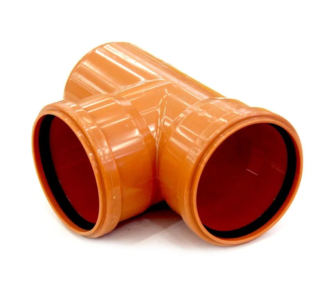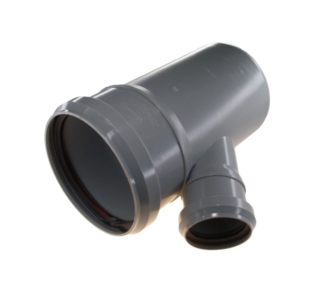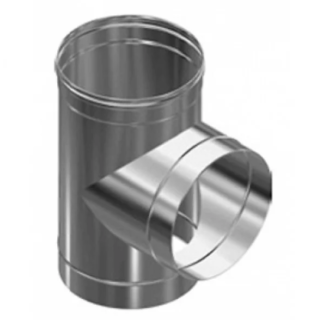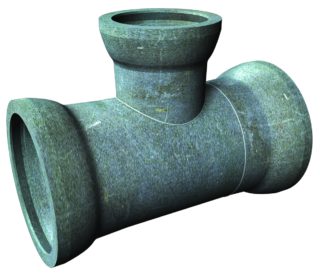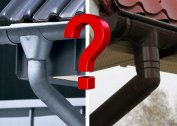Arrangement of internal and external sewage systems is impossible without the use of tees of various types. With their help, you can change the slope of the pipes, make an additional branching of the trunk, switch from one diameter to another, change the direction.
Definition and purpose of tees for sewer pipes
The sewer system, both internal and external, consists not only of pipes. Fittings are necessary for proper installation so that the line meets the technical requirements. Most construction companies and individuals use plastic for sewage, so the industry offers a wide selection of diverse tees that help make the system stable and safe.
The advantages of plastic products:
- light weight - all work can be performed without involving heavy construction equipment;
- ease of installation - the parts are equipped with special joints that do not need additional use of any materials;
- plastic is resistant to rust, so it lasts a long time;
- plaque is not delayed on the inner walls, which allows saving on frequent preventive measures;
- low cost of products.
Without the purchase of tees, it is possible to equip only a direct highway - without turns and forks, which does not allow you to use it comfortably.
In shops and construction supermarkets you can find parts for cast iron or steel sewers, but other methods of connection, for example, welding, are needed to use them. The principle of operation and the purpose of cast-iron or steel fittings are the same as for the plastic system.
Types of tees for sewage
The following types of fittings are used in the construction of the sewer line:
- Direct. They got their name because they are used for horizontal and vertical sections with an angle of inclination of 90 degrees. This is an integral element that is used in every system.
- Inclined tees. Needed to organize the flow at an angle of 45 degrees. Most in demand in internal systems to prevent potential clogging.
- Revision couplings are installed to facilitate pipe cleaning in particularly complex wiring. If a blockage still occurs, the master removes the plug and cleans the area with a cable.
- Equal bushing tees are needed where the pipe is split. The diameter is preserved, but an additional branch line appears.
- Multiple fittings. If the pipe diameter in the internal sewage system is 50 mm, and in the external one 110, then you need to conveniently connect these two structural elements. In this case, a part is selected that has a different diameter for connection in order to dock the internal and external sewers.
The number of tees is calculated in advance, during the design of the system, so that together with the pipes to purchase the right number and configuration of parts based on the documentation.
Production material
The most common materials that are used for the construction of private or urban sewers:
- steel;
- cast iron;
- plastic;
- ceramics;
- asbestos cement;
- corrugated pipes.
The advantage of stainless steel tees is that the material tolerates the negative effects of the environment well, has a type of connection in which pipe divergence and leakage are eliminated.Stainless steel is resistant to corrosion for a long time, so it does not wilt on the quality of water. It is used in public catering establishments, as it has a long service life.
Plastic tees are lighter in weight and cheaper to manufacture, but compete in strength with steel or cast iron. Using plastic, you can dock the internal sewer made of polymers and the external cast-iron duct. For this, additional materials will be needed so that a leak does not form. This method is practiced in apartment buildings. You can choose polymer pipes for pressure and pressureless sewer systems to withstand the pressure inside when the pump is running. For this, there are different types of plastic - several types of polyethylene, polypropylene, and metal plastic.
Ceramic fittings have served more than 100 years since installation. Resistant to temperature extremes and external mechanical influences, therefore it is more durable in operation than ordinary polymer or cast iron. The inner surface is smooth, with almost no roughness, which ensures a high flow rate. It is rare to clean the inside of the pipes, since no sticking of organic particles occurs. The material is chemically neutral - it is not damaged in contact with acids and alkalis. Ceramic tees are suitable for joining in the desired configuration of ceramic pipes. The dense structure protects the environment from sewage contents.
Asbestos cement is a material that is used for pressure and non-pressure structures. Asbestos-cement fittings and pipes are the cheapest of all available on the market, so they are suitable for arranging a budgetary sewage system in a private house or summer house.
Cast iron is the most common material in buildings of the old construction, therefore, repair of joints is sometimes required. To do this, the industry produces a variety of types of tees. For installation, welding or a bell method is used - it depends on what connection the parts will have.
Fittings for corrugated pipes are two-layer, that is, in structure they are similar to the main parts. The main type of connection is the bell.
Type of connection
In the installation, the following types of connections are used:
- bell-shaped;
- welding;
- couplings with clamps;
- thread;
- adhesive joint.
The bell is the most reliable and durable way. The fitting has an extension into which the pipe is inserted. Additional seals can be used - rubber or rags. The flow should move in the direction of the bell so that there are no blockages.
Welding is used in steel structures, cast iron or polymer. When connecting polymers, this method provides complete sealing, which makes it possible to connect a pump for transporting effluents. The limitation is the high internal pressure, which is able to break through the junction. For high-pressure lines, more durable types of polymers are used.
Couplings with metal clamps - this method involves joining with additional devices, in which the end of the pipe enters the coupling and is secured with a bracket. During operation, a discrepancy of metal elements may occur, which will entail depressurization of the line.
For adhesive bonding, a special compound is used, which is usually sold complete with fittings. There are a number of rules that you must follow in order to withstand the load. Typically, this method is used in non-pressure systems.
Thread is used for all materials except asbestos and ceramics. The threaded connection is mainly used for lightweight structures.
Tee sizes
Large home tees are rarely used in home sewers. Usually these are diameters of 50, 110 and 160 mm.The configuration depends on which section of the pipe must be connected, for example, when connecting an output pipe with a diameter of 50 mm to an external system of 110 mm.
Large sizes of tees for sewer pipes are necessary for the construction of an urban system or an apartment building. For these purposes, 400 and 500 mm sections are produced.
Rules for installation work
The installation of a sanitary sewer tee can be carried out independently, but take into account the tips:
- In horizontal wiring, it is recommended to use tees with an angle of 45 degrees to reduce the risk of clogging. In-line parts are not used.
- Take into account the direction of flow and the installation of the socket - he should look in the direction from which the liquid flows.
- Parts whose diameter exceeds 50 mm are additionally mounted on the wall with vertical wiring.
- When replacing the O-rings, the old rubber is left in place. To better fit the parts, they are lubricated with liquid soap.
The easiest way to connect plastic parts, because they are lighter in weight and do not require outside help. For trimming, it is better to use a fine-tooth hacksaw for metal in order to less damage the edge of the pipe. After that, the end is cleaned with sandpaper. Next, the connection is going according to the scheme.
To collect the sewage section using a tee by welding, you need to prepare additional devices that heat the ends of the plastic, after which they are connected and held for 20 seconds.
Cost of sewer tees
The cheapest parts for sewage are plastic and asbestos-cement. Following them at cost is cast iron, stainless steel, ceramics. The price depends on the amount of consumable, as well as on the configuration of the product. The larger the diameter and the more complex the design, the more expensive the fitting will cost.
An inclined tee with a cross section of 50 mm will cost 150 rubles. A PVC fitting with a diameter of 500 mm will cost about 2,000 rubles.
Arrangement of external sewage system will cost more due to materials that have a higher density, are more resistant to mechanical stress and environmental conditions. In general, parts and pipes of external wiring are higher in cost than the same in size, but intended for internal work.
